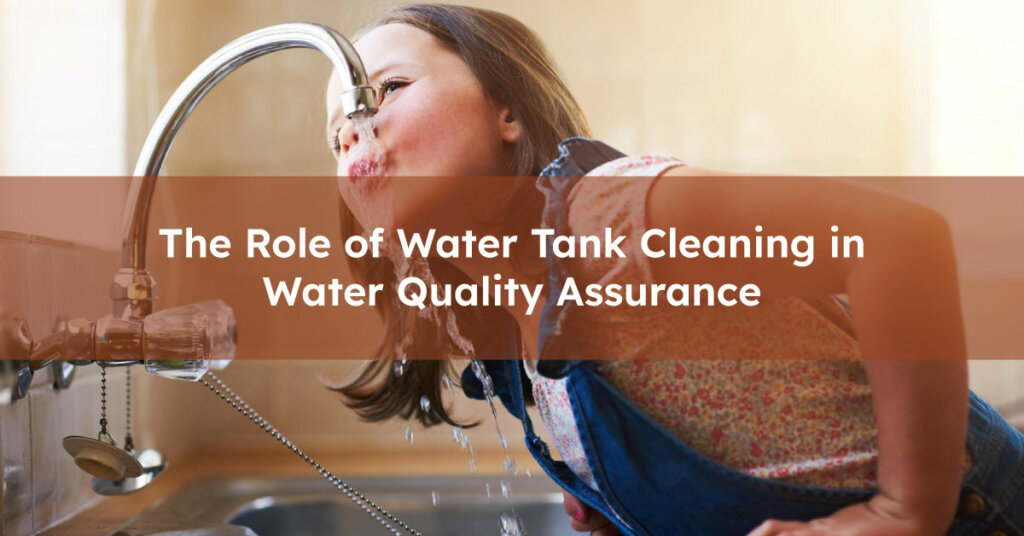Did you know that water tank maintenance is crucial for ensuring clean and safe water? Water contamination can lead to various health risks and compromise the quality of the water supply. That’s why regular cleaning and proper sanitation practices for water tanks are essential in preventing waterborne diseases and maintaining water quality.

At Endeavor Clean, we understand the importance of water quality assurance. That’s why we offer professional water tank cleaning services in Dubai.
Table of Contents
Key Takeaways
- Regular water tank cleaning is crucial for preventing health risks and ensuring water quality.
- Contaminated water can cause gastrointestinal issues, skin infections, and waterborne diseases.
- Water tanks can become contaminated from external pollution, animal droppings, and roof runoff.
- Cleaning and disinfecting water tanks removes harmful microorganisms and prevents biofilm and algae growth.
- Compliance with cleaning frequency and standards is essential for maintaining safe and high-quality water.
- Professional water tank cleaning services provide expertise in meeting regulatory standards and ensuring thorough sanitation.
The Importance of Water Quality
Water quality is a critical factor that directly affects human health and wellbeing. Poor water quality can lead to a variety of health issues, including gastrointestinal problems, skin infections, and even serious diseases. It is essential to understand the importance of clean water and the risks associated with poor water quality to ensure the safety of our water supply.
Health Implications of Poor Water Quality
Poor water quality can have severe health implications, posing risks to individuals and communities. Here are some of the health risks associated with poor water quality:
- Gastrointestinal problems: Contaminated water can cause diarrhea, nausea, and stomach cramps, leading to dehydration and electrolyte imbalances.
- Skin infections: Exposure to polluted water can result in skin irritations, rashes, and infections.
- Waterborne diseases: Contaminants such as bacteria, viruses, and parasites can cause diseases like cholera, typhoid, hepatitis, and dysentery.
These health risks highlight the need for ensuring clean and safe water for consumption and other domestic uses.
How Water Tanks Can Become Contaminated
Water tanks can become contaminated through various sources, which can compromise the quality of stored water. Here are some common causes of water tank contamination:
- Roof runoff: Rainwater flowing from rooftops can carry debris, dirt, and pollutants into water tanks.
- Animal and bird droppings: Birds, rodents, and other animals can contaminate water tanks with feces, carrying harmful microorganisms.
- External pollution: Industrial emissions, agricultural runoff, and environmental pollutants can find their way into water tanks, impacting water quality.
Understanding how water tanks can become contaminated is crucial in recognizing the importance of regular cleaning and proper maintenance to prevent waterborne diseases and ensure clean and safe water supply.
| Contaminant | Source | Health Risks |
|---|---|---|
| Bacteria | Animal droppings | Gastrointestinal infections |
| Viruses | Human waste | Cholera, hepatitis, norovirus |
| Chemicals | Industrial pollutants | Cancer, organ damage |
| Sediments | Roof runoff | Choking hazards, clogged pipelines |
Note: The table above illustrates common contaminants found in water tanks, their sources, and associated health risks.
Proactive measures, such as regular water tank cleaning and maintenance, are essential to ensure the cleanliness and safety of stored water.
Water Tank Cleaning and Water Quality
Proper water tank cleaning procedures are an effective way to improve water quality. Regular cleaning and maintenance not only eliminate sediments, debris, and organic matter from the tank but also help remove potential breeding grounds for bacteria and other contaminants. By removing these sources of contamination, water tank cleaning plays a significant role in ensuring clean, clear, and safe water for consumption.
The Impact of Cleaning on Removing Contaminants
Cleaning water tanks helps remove various contaminants that can compromise water quality. Here are some key benefits of water tank cleaning:
- Prevention of Biofilm Formation: Biofilm is a slimy layer that forms on the inner surfaces of water tanks. It harbors bacteria and other pathogens, making the water unsafe for consumption. Regular cleaning and disinfection prevent the formation of biofilm, ensuring the removal of harmful microorganisms.
- Preventing Algae Growth: Algae growth in water tanks can lead to taste and odor issues and affect water quality. Cleaning and proper maintenance control algae growth, keeping the water clear and free from any unpleasant tastes or smells.
- Removal of Sediments and Debris: Sediments and debris can accumulate over time in water tanks, compromising water quality. Cleaning helps remove these impurities, ensuring clean and clear water for consumption.
- Water Tank Disinfection: Cleaning involves not only physical removal but also the application of disinfectants to kill bacteria and viruses. Disinfection further enhances water quality by eliminating harmful microorganisms.
By addressing these aspects, regular water tank cleaning plays a crucial role in maintaining water quality and preventing waterborne diseases. It is essential to follow proper cleaning procedures and adhere to recommended cleaning intervals to ensure the safety and cleanliness of the stored water.
For more detailed information and helpful tips on water tank cleaning, refer to our water tank cleaning comprehensive guide.
Frequency and Standards for Water Tank Cleaning
The frequency of water tank cleaning depends on various factors, including the size of the tank, water usage, and environmental conditions. Generally, it is recommended to clean domestic water tanks at least once a year. However, in areas with high water contamination or heavy sedimentation, more frequent cleaning may be necessary.
Government regulations and standards often outline specific requirements for water tank cleaning to ensure water quality and public health. These regulations aim to prevent the buildup of contaminants and maintain clean and safe water supplies. Compliance with these standards is essential to protect the health and well-being of individuals and communities.
Professional water tank cleaning services, such as those offered by Endeavor Clean, can assist in meeting these standards. Our experienced team follows industry best practices and adheres to government regulations to provide expert water tank cleaning, inspection, and testing services.
| Recommended Cleaning Interval | Water Tank Cleaning Standards | Government Regulations | Professional Cleaning Services |
|---|---|---|---|
| At least once a year for domestic water tanks | Specific requirements outlined to ensure water quality and public health | Compliance with regulations to prevent contamination and maintain clean water supplies | Expert cleaning, inspection, and testing services provided by Endeavor Clean |
Table: Recommended cleaning interval, water tank cleaning standards, government regulations, and professional cleaning services.
Regular water tank inspection and monitoring is also crucial to detect any issues that may affect water quality. In addition to cleaning, professional water tank cleaning services can include thorough inspection to identify potential hazards, leaks, or faults in the tank structure.
Water quality testing is another important aspect of maintaining clean water tanks. Testing helps ensure that the water stored in the tanks meets the required quality standards and is safe for consumption. Professional water tank cleaning services often provide comprehensive water quality testing to ensure that the highest standards are met.
By following recommended cleaning intervals, adhering to government regulations, and availing professional cleaning services, individuals and communities can maintain clean water tanks and ensure the supply of safe and high-quality water.
Conclusion
In conclusion, regular water tank cleaning and maintenance are essential for ensuring a clean and safe water supply. By removing contaminants, preventing bacterial and algae growth, and adhering to recommended cleaning intervals, you can maintain the highest water quality standards.
At Endeavor Clean, we understand the importance of water quality assurance. Our professional water tank cleaning services in Dubai are designed to help you maintain clean and hygienic water storage systems. Whether you’re a homeowner or a business owner, our team is committed to providing the expertise and services you need.
To learn more about water tank cleaning and maintenance, make sure to check out our comprehensive guide to water tank cleaning in Dubai. It provides valuable information and tips to ensure the cleanliness and safety of your water supply. Take the first step towards a clean and safe water storage system by scheduling your water tank cleaning and maintenance with Endeavor Clean today. Contact us here.
FAQ
Why is tank cleaning required?
Tank cleaning is essential to ensure the water stored remains safe for consumption and use. Over time, tanks can accumulate sediments, bacteria, algae, and other contaminants that can compromise water quality. Regular cleaning prevents the growth of harmful microorganisms, maintains the structural integrity of the tank, and ensures the water supply is free from pollutants and safe for use.
What is the cleaning procedure for a water tank?
The cleaning procedure for a water tank typically involves several steps: draining the tank to remove any water and sediments, scrubbing the interior surfaces to remove buildup and biofilm, applying a disinfectant to kill any remaining bacteria and microorganisms, thoroughly rinsing the tank with clean water, and finally, refilling the tank for use. It’s important to follow safety guidelines and use appropriate cleaning agents during the process.
What happens if a water tank is not cleaned?
If a water tank is not cleaned regularly, it can lead to the accumulation of sediments, bacteria, algae, and other harmful contaminants. This can cause the water to become unsafe for consumption, lead to unpleasant tastes and odors, and increase the risk of waterborne diseases. Additionally, the buildup of sediments and biofilm can corrode the tank and damage its structural integrity over time.
What are the disadvantages of dirty water tanks?
Dirty water tanks pose several disadvantages, including the risk of harboring and proliferating harmful pathogens that can cause waterborne diseases. The quality of the water can significantly deteriorate, resulting in foul tastes and odors, making it unfit for consumption or use. Additionally, the accumulation of sediments and contaminants can lead to the corrosion and degradation of the tank itself, shortening its lifespan and potentially leading to costly repairs or replacements.




